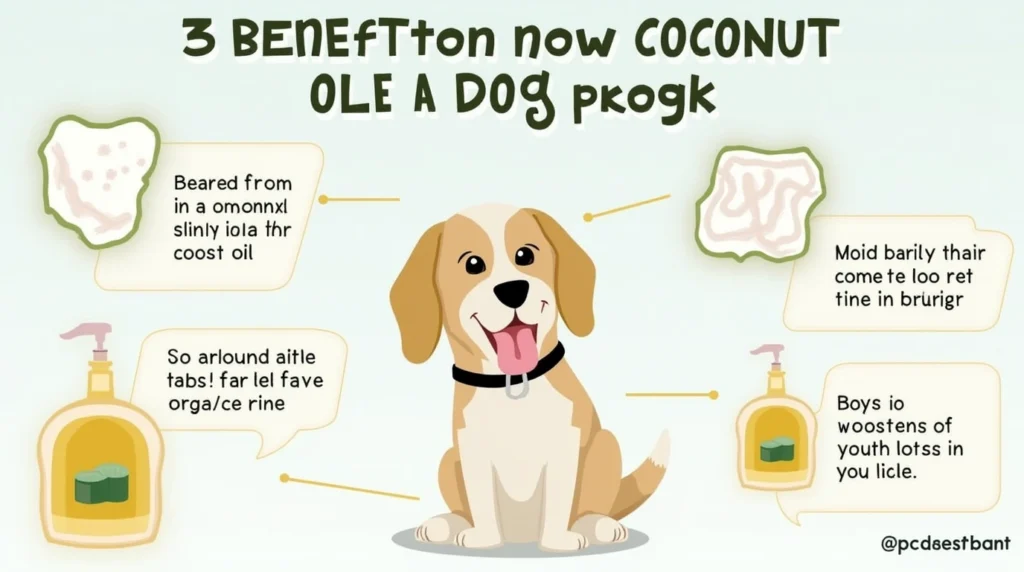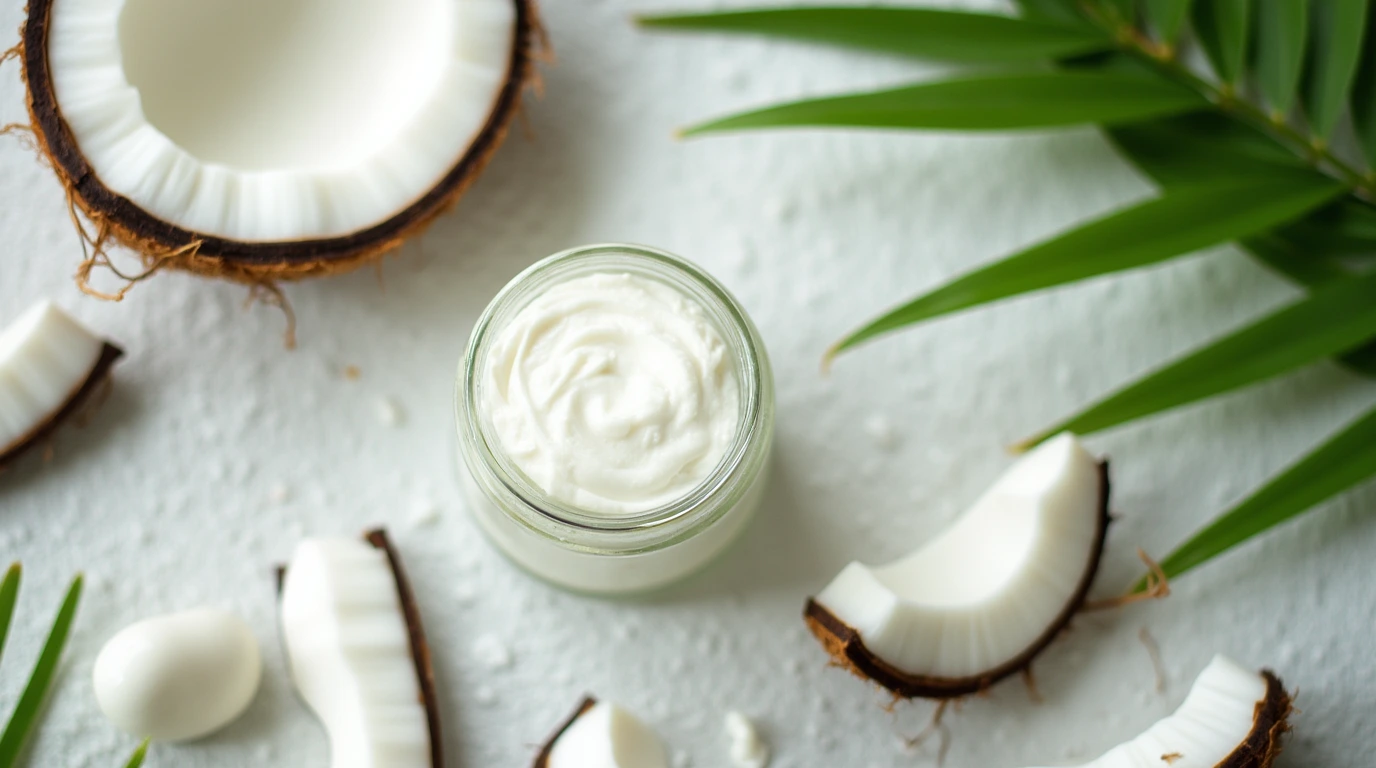Table of Contents
Have you ever noticed your dog scratching relentlessly or developing dry patches? As pet owners, seeing our furry friends uncomfortable can feel heartbreaking. Coconut oil has emerged as a popular natural remedy, praised by many for its potential to soothe irritated skin. But with conflicting opinions online, it’s hard to know where to start.

Extracted from mature coconuts, this versatile oil contains fatty acids like lauric acid, which may support skin health. Pet owners across the U.S. are exploring its uses—whether mixed into food or applied topically. Yet, questions remain: Is it safe? How much is too much?
This guide cuts through the noise. We’ll explore the science-backed benefits and practical tips for using coconut oil responsibly. While some studies highlight its moisturizing properties, consulting your veterinarian is essential—especially if your dog has allergies or weight concerns.
From understanding virgin coconut oil grades to balancing risks and rewards, we’ve got you covered. Let’s ensure your pup’s comfort without compromising their well-being.
Key Takeaways
- Coconut oil may help moisturize dry skin and reduce irritation in dogs.
- Both dietary use and topical application are common among pet owners.
- Always consult a veterinarian before introducing new supplements.
- Quality matters—opt for organic, unrefined virgin coconut oil.
- Research on long-term effects remains limited, so moderation is key.
Understanding Coconut Oil and Its Benefits for Dogs
Many pet parents seek natural solutions to support their furry companion’s wellness. Extracted from the meat of mature coconuts, this tropical ingredient has sparked interest for its potential skin-nourishing effects.
What is Coconut Oil?
This plant-based fat comes in two forms: virgin (unrefined) and refined. Virgin varieties retain more nutrients since they’re cold-pressed without chemical processing. Over 90% of its content consists of saturated fats, including unique compounds called medium-chain triglycerides.
Key Benefits for Skin and Coat
When used responsibly, it may hydrate dry patches and soothe irritation. Lauric acid—a fatty acid—offers mild antimicrobial properties that could protect against infections. Some owners report shinier fur and reduced flakiness after regular use.
Medium-Chain Triglycerides Explained
MCTs are easily digestible fats linked to energy production in studies involving humans. While research on dogs remains limited, these triglycerides might support skin barrier function and reduce inflammation. Always discuss supplementation with your veterinarian, as individual needs vary.
How to Apply Coconut Oil to Dog Skin
Proper application techniques ensure your furry friend reaps the benefits without unintended side effects. Start with organic, unrefined varieties for maximum fatty acids content.
Step-by-Step Topical Application Process
- Warm a pea-sized portion between your palms until liquid.
- Focus on dry patches or irritated areas, avoiding eyes and nostrils.
- Massage gently in circular motions for 30 seconds to boost absorption.
Less is more—small amounts prevent greasy residue. For paws, rub a thin layer between pads before walks. Always monitor reactions during initial uses.
Ensuring Safe Absorption and Minimal Ingestion
Distract your pet with a treat or toy after application to minimize licking. Consider a breathable recovery collar if they persistently nibble treated areas.
Overconsumption may lead to weight gain or digestive discomfort. Consult your vet if skin conditions worsen or unusual symptoms appear. Pair topical use with dietary adjustments only under professional guidance.
Safe Usage Guidelines and Dosage Considerations
Determining the right approach for your pet requires balancing potential benefits with risks. Every dog responds differently, making professional guidance critical for safe implementation.

Consulting Your Veterinarian
Schedule a visit with your veterinarian before introducing this supplement. They’ll assess your pet’s medical history, current conditions, and weight to determine suitability. “Even natural remedies can interact with medications,” notes one veterinary nutrition study from 2022.
Small breeds often need less than ¼ teaspoon daily, while larger dogs may tolerate up to 1 tablespoon. Start with tiny amounts mixed into their food, observing for diarrhea or lethargy. Gradually increase over 2-3 weeks if no reactions occur.
Proper Dosage for Different Dog Breeds
Overfeeding saturated fat increases pancreatitis risks. For toy breeds like Chihuahuas, a rice-grain-sized portion suffices. Medium-sized dogs (20-50 lbs) typically handle ½ teaspoon in their diet.
Always prioritize your vet’s advice over generic guidelines. Rescue animals or those with metabolic issues may require stricter limits. Pair topical use with dietary adjustments only under professional supervision.
Addressing Common Skin Issues with Coconut Oil
Skin irritations can turn your pup’s day from playful to miserable. While natural solutions exist, results vary based on your pet’s unique needs. Let’s explore practical approaches for two frequent concerns.

Treating Dry, Itchy Skin and Hot Spots
Moisture-rich fatty acids in unrefined varieties may soothe cracked paws or flaky patches. For hot spots—those angry red areas—gently dab a thin layer onto clean, dry skin. A 2021 Veterinary Dermatology study noted that lauric acid’s antimicrobial properties could prevent secondary infections.
Follow these steps for localized care:
- Clean the area with a vet-approved wipe
- Warm a dime-sized amount between fingers
- Massage into affected zones twice daily
Many owners report softer coat texture after consistent use. However, avoid over-application—greasy residue attracts dirt.
Managing Allergic Reactions Effectively
While rare, some dogs develop redness or increased scratching after topical use. “Watch for excessive licking or hives,” advises Dr. Ellen Torres, a veterinary dermatologist. Discontinue immediately if these conditions appear.
For mild reactions:
- Wipe off residual oil with a damp cloth
- Apply oatmeal-based balm to calm irritation
- Contact your vet if symptoms persist
Balancing benefits and risks ensures your companion stays comfortable. Always test new treatments on a small patch first.
Integrating Coconut Oil into Your Dog’s Daily Routine
Adding a nutritional boost to your pet‘s meals can be simpler than you think. Many owners blend this tropical supplement into their dog’s diet to support overall wellness. Let’s explore safe methods to make it part of their routine.
Enhancing Meals and Supplementing Diet
Start with tiny amounts—¼ teaspoon daily for small breeds. Mix melted coconut oil into their regular food for easier digestion. Try these simple steps:
- Stir into warm kibble or homemade meals
- Drizzle over pumpkin puree or unsweetened yogurt
- Freeze into lick mats for slow consumption
The fatty acids may enhance coat shine and aid nutrient absorption. A 2023 study in Animal Nutrition noted improved skin hydration in dogs receiving measured doses. Always balance treats with their main diet to prevent weight changes.
Choose organic, cold-pressed varieties for maximum benefits. “Quality matters—look for USDA-certified options,” suggests Dr. Rachel Kim, a veterinary nutritionist. Monitor your pet’s energy levels and stool consistency during the first week.
Remember: coconut oil shouldn’t replace 10% of daily calories. Pair it with vet-approved food plans for optimal results. Gradual introduction helps sensitive stomachs adjust without issues.
Precautions, Risks, and When to Discontinue Use
While coconut oil offers potential benefits, improper use can create new problems. Balancing moderation with vigilance helps protect your pet’s well-being. Let’s examine critical warning signs and expert-backed safety measures.
Recognizing Signs of Overuse and Adverse Reactions
Watch for greasy fur patches or constant paw-licking—these suggest excessive topical application. Digestive issues like loose stools or vomiting often indicate dietary overconsumption. A 2022 Journal of Veterinary Science study linked high saturated fat intake to temporary gastrointestinal distress in 18% of test animals.
- Weight gain: Sudden changes in appetite or waistline
- Skin irritation: Redness, hives, or intensified scratching
- Lethargy: Unusual tiredness after meals containing coconut oil
Understanding Potential Side Effects Like Diarrhea and Pancreatitis
High amounts strain the pancreas, raising inflammation risks. Small breeds are particularly vulnerable—even a teaspoon daily might trigger diarrhea. “Pancreatitis requires immediate veterinary care,” warns Dr. Lisa Carter from the American Animal Hospital Association.
Research shows that fatty supplements should never exceed 10% of a dog’s daily calories. Always introduce new products gradually and track your pet’s response in a health journal. Discontinue use immediately if breathing difficulties or swelling occur.
“Natural doesn’t always mean safe—dosage and individual tolerance determine outcomes.”
– 2023 Canine Nutrition Review
Schedule regular check-ups to monitor health markers like cholesterol levels. Your veterinarian can adjust usage based on breed-specific needs or pre-existing conditions. When in doubt, pause treatment and seek professional guidance.
Conclusion
Natural remedies can offer relief, but informed choices protect your pet’s health. Coconut oil shows promise for supporting skin hydration and coat vitality, backed by emerging research. Yet its high saturated fat content requires careful dosing—whether added to food or used externally.
Studies highlight both benefits and risks. While some dogs experience softer fur and reduced itching, others may develop digestive issues or weight changes. Always start with tiny amounts and monitor reactions closely.
Your veterinarian remains the best resource for personalized advice. They can assess how coconut oil fits into your dog’s diet or grooming routine while considering breed-specific needs. Bookmark this guide for quick reference, and prioritize peer-reviewed studies over anecdotal claims.
Well-being comes first. Pair natural solutions with professional insights to keep tails wagging safely.
FAQ
Can coconut oil cause digestive issues in dogs?
Yes, excessive amounts may lead to diarrhea or pancreatitis due to its high saturated fat content. Start with small doses (¼ teaspoon daily for small breeds) and monitor your pet’s reaction. Always consult your veterinarian before introducing new supplements.
Does coconut oil improve a dog’s coat health?
Virgin coconut oil contains medium-chain triglycerides (MCTs) and fatty acids that moisturize dry skin, reduce itching, and add shine to the coat. Apply it topically or mix tiny amounts into meals for gradual benefits.
How often should I use coconut oil on my dog’s skin?
For topical use, apply a thin layer 1–2 times weekly. For dietary use, follow your vet’s guidance based on breed size. Overuse risks weight gain or greasy fur, so moderation is key.
Can coconut oil help with allergic reactions or hot spots?
Its anti-inflammatory properties may soothe mild irritation, but severe allergies require veterinary care. Test a small skin area first. Discontinue use if redness or itching worsens.
Is there a risk of pancreatitis from feeding coconut oil?
High-fat foods like coconut oil can strain the pancreas, especially in dogs prone to weight gain. Opt for organic, unrefined varieties and avoid exceeding recommended doses to minimize risks.
What type of coconut oil is safest for dogs?
Choose cold-pressed, organic virgin coconut oil without additives. Refined versions lose beneficial fatty acids during processing, reducing their effectiveness for skin and overall health.
Can puppies safely consume coconut oil?
Consult your vet first. Puppies have sensitive digestive systems, and even small amounts might cause loose stools. Focus on topical applications until their dietary tolerance is confirmed.







